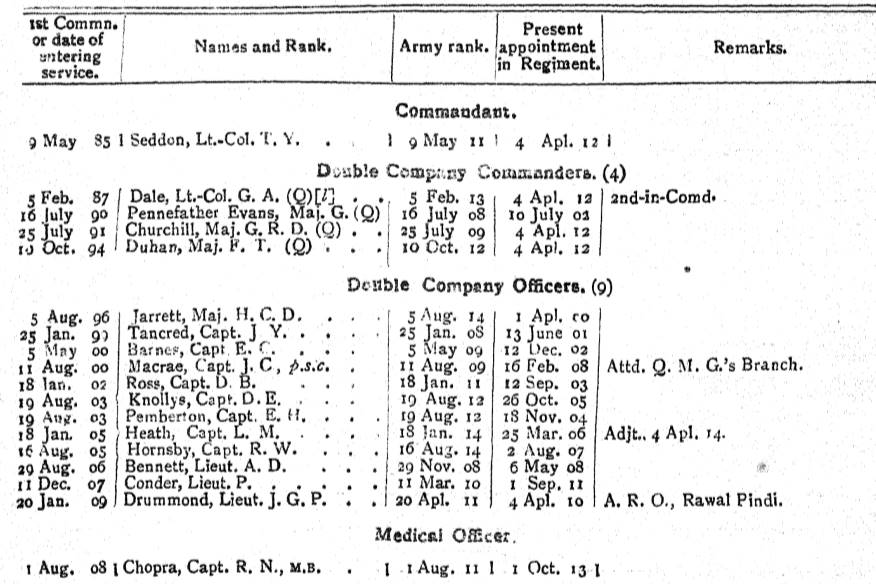This article is about the 19th Punjabis and will help you to research the Regiment and the soldiers who served with it during the First World War. I have written a separate article about the 2nd Battalion 19th Punjabis and a series of guides to help you to research soldiers who served in the Indian Army. To view the guides click on the blue links below:
The 19th Punjabis in the First World War
Lineage: Formed at Phillour by Lieutenant J. F. Stafford in 1857 from ”four companies transferred from the 2nd and four from the 7th Punjab Police Battalion and designated the 7th Regiment of Punjab Infantry”. Then in 1861, it became the 23rd Regiment of Bengal Native Infantry and in the same year the 19th Regiment of Bengal Native Infantry. Then in 1864 the 19th (Punjab) Regiment of Bengal Native Infantry and the 19th Punjab Infantry in 1901. In 1903 it became the 19th Punjabis and then the 1st Battalion, 14th Punjab Regiment in 1922.
Class Composition of Battalion in 1914: 4 Companies of Sikhs, 2 Companies of Punjabi Musalmans and 2 Companies of Pathans. 1919: 2 Companies of Sikhs, 1 Company of Punjabi Musalmans and 1 Company of Pathans.
Location in August 1914: The 19th Punjabis was stationed at Quetta (Balochistan, Pakistan), having arrived from Dargai (Khyber Pakhtunkhwa, Pakistan) on 31st March 1914.
The 19th Punjabis was stationed at Quetta when the First World War began in August 1914 and had been inspected earlier in the year by Major-General J. Blomfield, Commanding 1st (Peshawar) Division who reported:
This is a good, sound, reliable, and efficient regiment, in which an excellent spirit seems to prevail. The men are of good stamp, healthy and cheerful, and physically very fit.
Instruction is on sound lines, and the officers show sound appreciation of the correct use of ground.
The Indian officers, when confronted with sudden changes in the field, involving prompt action, show readiness and resource. The field work is good and intelligent. Interior economy is satisfactory.
Due economy is practised, as regards clothing deductions, and the slightly high outfit cost has been brought to notice. The unit is quite fit for active service.
Confidential review reports on Indian Army units for 1913-1914: IOR/L/MIL/7/17023
While the 19th Punjabis remained in India for the majority of the First World War, it sent large drafts abroad including to the 15th Ludhiana Sikhs and 59th Scinde Rifles (Frontier Force). The 19th Punjabis raised a second battalion at Hyderabad Sind (Sindh, Pakistan) on 12th January 1917 which was disbanded on 24 August 1922. I have written about the Battalion in a separate article: 2nd Battalion 19th Punjabis. The extract below was taken from the October 1914 Indian Army List and recorded the British officers serving with the Regiment.
War Diary of the 19th Punjabis
There is only one war diary for the 19th Punjabis which can only be viewed at the National Archives. I have transcribed the entire war diary below.
- Date: May 1919
- Sistan and Cordon Field Force, East Persia Force
- Reference: WO 95/5415
- Notes: It is unfortunate that the only war diary for the 19th Punjabis consists of a single month.
Further Sources for the 19th Punjabis
A very good source of information for the 19th Punjabis are its confidential reports held at the British Library: Confidential Reports on Regiments etc. These confidential reports also contain the annual reports of the British officers serving with the Regiment. However, when the 19th Punjabis was abroad only its Depot and the British officers serving there are reported on. For information regarding the British and Indian officers who served with the 19th Punjabis, the Indian Army List should be consulted.
There is also a regimental history: History of the 1st Battalion 14th Punjab Regiment, Sherdil-Ki-Paltan, (late XIX Punjabis) by Lieutenant-Colonel G. H. Thompson which has been reprinted by the Naval and Military Press.
The War Diary of the 19th Punjabis
May 1919, East Persia Force, WO 95/5415
03 May 1919 – Moveable Column organized for possible operations against Bolsheviks on Persian Frontier and inspected by Officer Commanding troops. Cook Tibana died in hospital from Broncho Pneumonia. [Cook Tibana’s name is spelt Tiwana in the Commonwealth War Graves Commission’s records. Indian names were often spelt phonetically and it is usual to find multiple spellings of the same name].
15 May 1919 – Brigade sports held.
16th May 1919 – Information received of the desertion of two Pathans from No. 1 Company at Kuchan.
20th May 1919 – Officer Commanding troops inspected the force.
24th May 1919 – Officer Commanding force inspected transport of movable column.
26th – 28th May 1919 – Regiment inoculated against cholera.
31st May 1919 – Regiment moved camp into a garden. Ramazan began. Weather First half of month wet and stormy. Second half hot and dusty.
Postponement of departure to India first of two companies and later of the whole regiment was ordered during the month.

